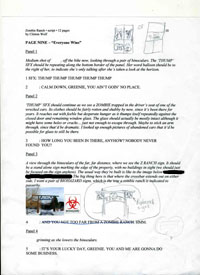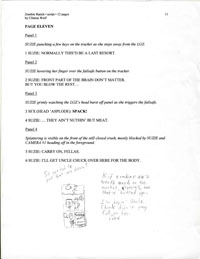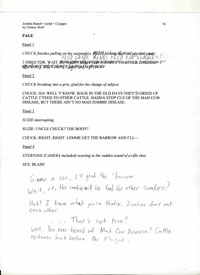We’re coming up on the first Anniversary of Zombie Ranch. It’s not quite here yet. The site went live on September 25th, 2009, and the first storyline comic was published Oct. 2nd, timed to when the doors opened to the exhibit hall at the first annual Long Beach Comic Con.
Zombie Ranch, more than anything, is a child of two conventions. I’ve told the story many times before of Dawn’s first illustration of the then-nameless cowgirl facing down zombie hordes, and Dawn’s mad thought that she wasn’t hunting or fleeing them, but ranching them. But the truth is, there’s a lot that comes between looking at something and thinking “That might make a good story”, and actually getting a story produced. Two conventions were the fuel.
First was the San Diego Comic-Con, because Dawn drew On The Zombie Ranch as part of her prep for the Art Show. She tends to have a binge period of a few weeks staying up late to create some new pieces in addition to the prints already planned for auction. So: no Art Show, no binge period, and possibly no Zombie Ranch illustration.
Beyond that though, the piece ended up in a bid war, and eventually sold for $85, still Dawn’s record for an Art Show offering. That response led us to believe that the concept had some legs to it. It was one thing if we thought it might be cool, but if no one else cared, why bother? Well, of course the whole idea is that if you’re convinced your idea has merit you proceed regardless, but remember here you’re dealing with two people of uncertain ego and little experience. That sale was a big boost to the esteem, and somewhere out there a gent named Gregor Mortis has the original that started all this. That was the name on the sale tally, anyhow, and whether real or not, his money was.
Still, by the end of San Diego all that really had us doing was still just kicking around the idea of a story based on Zombie Ranch. I don’t think we actually started bringing it to life until around a year ago this time. I remember because my parents had taken us to brunch for my birthday and it was there that my dad mentioned Long Beach Comic Con had cashed the check he fronted us for an application we’d made months back to get Dawn into the Artist’s Alley there. We hadn’t heard anything and so had pretty much given up on it. Now, suddenly, was the heavy implication we’d been accepted, which we shortly confirmed with the LBCC management. Last year LBCC was held at the beginning of October, meaning we had about a month to prepare for our first ever outing being exhibitors.
And that was also about the time where we decided to try to put together Zombie Ranch as both a webcomic and print comic in time for the convention. This was an absolutely insane idea in that short amount of time, especially with me working full time and Dawn going to school, but I’ll say this about insanity: it’s a driving force. I managed to get a full working draft of the first arc done in between trying to get permits and all the other exhibiting necessities arranged, which I was also bumbling through as a first-timer. Dawn meanwhile was going crazy trying to put together hosting and a website, plus draw and color everything in time to be able to hand over a proof to a contact at her college who was going to do a small print run for us on short notice.
September became a mad, mad month of equal parts creativity, resource wrangling, and frustration. We did not succeed entirely in our ambitions, scaling back from the original idea of a 12 page comic with a complete (if compressed) storyline, to a 6 page “sneak preview” mini-comic, and even that nearly drove us to the edge of exhaustion. In addition to the story we were creating characters almost from scratch… in my first draft Suzie started with the name “Jodi Mills”, which is more or less completely different than what we ended up calling her. Also I would be remiss if I didn’t mention the hard drive crash that we thought not only meant we’d lost all the work on the comic so far, but all of Dawn’s digitally stored artwork, period.
We got through that. We navigated through every obstacle thrown our way and got a webcomic up and running and an Artist’s Alley table together complete with Dawn’s portfolios and prints, two mini-comics, and a bunch of free sticker swag. It was hugely stressful, but in the end that insane, self-imposed deadline for Long Beach was what took Zombie Ranch from a mere idea to a reality. Otherwise, who knows how long it would have remained on the backburner waiting for us to “find the time”?
That said, I’m certainly looking forwards to a more leisurely lead up to this year’s 2nd Annual Long Beach outing. But this time, we’ll have a full print issue to sell, and most likely some other exciting news. Stay tuned!










